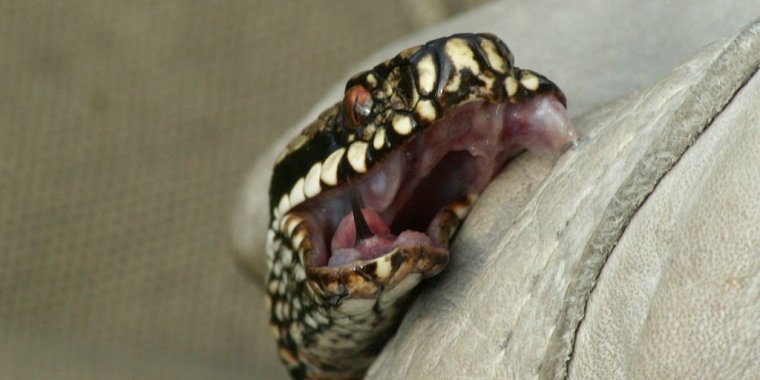| News / Science News |
Snakebite resolution set for Health Assembly approval
Efforts to tackle snakebite — a recent addition to the WHO’s list of neglected tropical diseases (NTDs) — will take a step forward this month with a resolution set to be approved at the World Health Assembly.

Vipera berus biting a leather glove. ![]()
Poisonous snake bites kill about 90,000 people a year, thousands more than other deadly NTDs, and leave a further 400,000 with lost limbs, blindness and trauma. They particularly affect the very poor, such as barefoot farmers in low- and middle-income countries.
Tackling the problem is tricky for various reasons: for example, victims are often in remote areas and need treatment fast; health workers cannot easily identify the culprit with certainty; and anti-venom treatments are expensive.
The WHO resolution is sponsored by Costa Rica and Colombia and co-sponsored by 25 other countries. It urges countries to assess impacts, share antivenom technology, support research on new medical tools, and educate health workers about how to respond.
One key issue, which Medécins Sans Frontières-MSF has been campaigning on, is the need to manufacture more anti-venoms. Production is expensive and the products — biological agents generated by manipulating the immune system of horses — have a short shelf-life.
The drug company Sanofi produced the last batch of its effective anti-venom in 2014. This means people affected by snake bites turn to poor-quality, cheaper anti-venoms.
Another key issue is the dearth of basic information about the incidence of snakebite.
A few countries are trying to gather data. In India, where an estimated 50,000 people die of snakebite each year, the Big 4 Mapping Project has just completed its first year of real-time mapping to help build a picture of snake activity across the country.
It involved enlisting around a thousand screened volunteers — including snake-rescuers, naturalists and forestry workers — to upload photograph sightings of India’s four most medically important snakes, along with information such as location, time of day and weather.
Another project that began in March in Nepal and Cameroon, Snake-Byte, is looking to understand the epidemiology and impact of snakebite.
And an app developed by the same team at the Institute of Global Health, dubbed SNAPP, will use machine learning to help health workers by identifying a snake from a photo supplied by them, a victim or a bystander. (SciDev.Net)
YOU MAY ALSO LIKE




